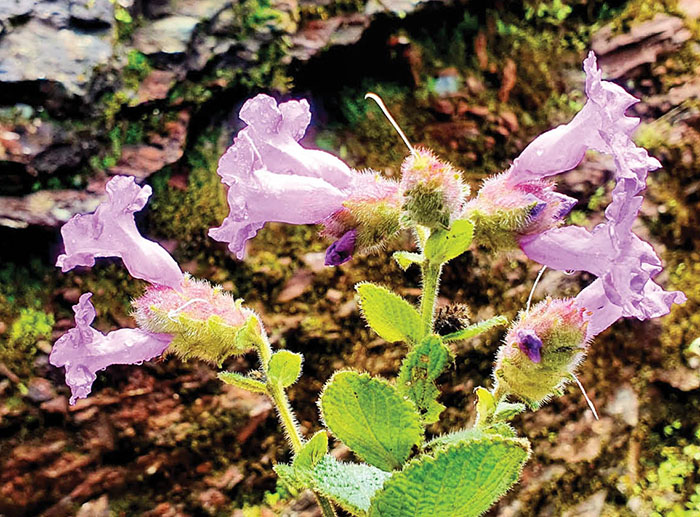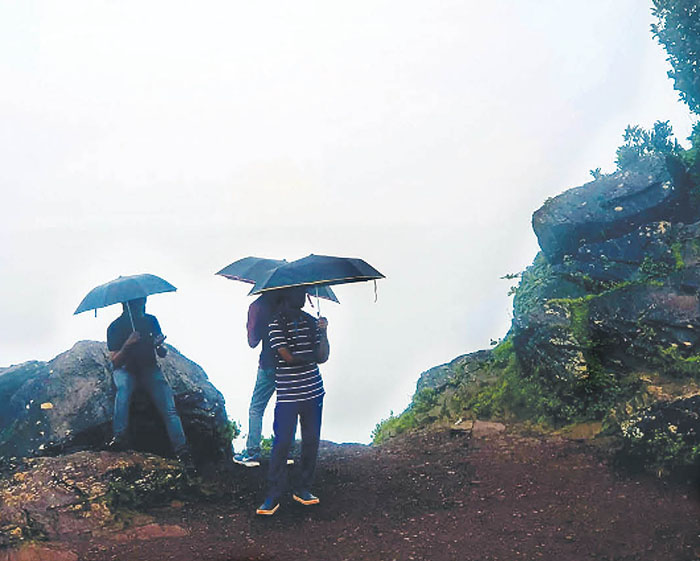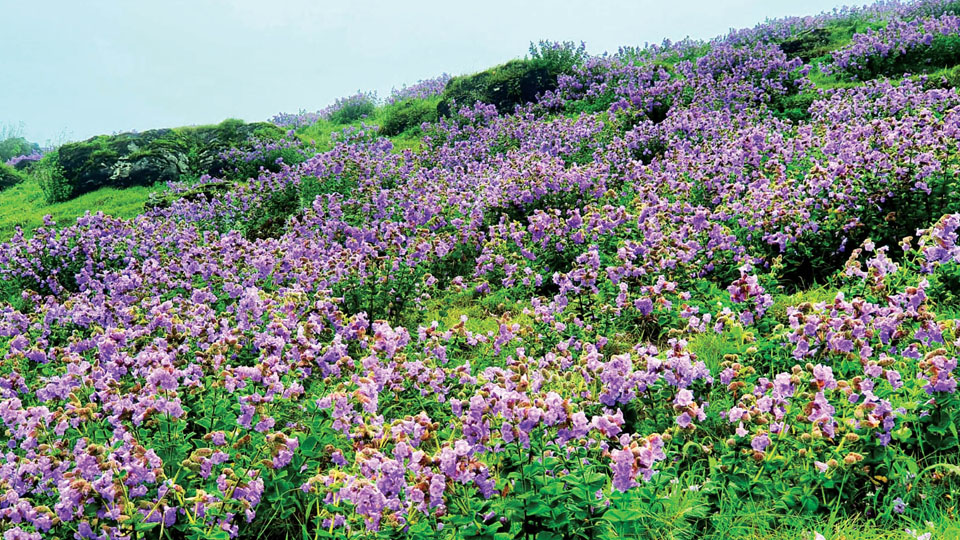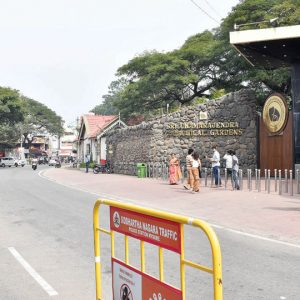By Dr. K. Javeed Nayeem
As you are all in the midst of celebrating a very colourful Dasara festival back in Namma Mysuru, my family and I are celebrating a different kind of equally colourful festival faraway, in Chikmagalur. This is the beautiful place I belong to and this is the place where the beautiful Kurunji flowers (Strobilanthhes kunthiana) are right now in bloom, on the slopes of the Bababudangiri Hills, that form a magnificent and now much misty backdrop, for the quaint, old-fashioned town.
For the benefit of those who may not know what I am talking about and therefore wondering what could be a better attraction for me, than our annual Dasara that has been attracting people from far and wide over many decades, I’ll do a bit of explaining. The Kurunji blossoms are a kind of purple flowers, that bloom en-masse, on the expansive slopes of the high hills of the Western and Eastern Ghats, that traverse the Southern part of our country. They are found in places like the Nilgiris, Kodaikanal, Munnar, Kodagu and Chikmagalur, between an altitude range of 1,300 to 2,400 metres (4,000-8,000 feet).
In fact, they have given the Nilgiri Hill Range its unique name! In Kodaikanal, just three kilometres away from the lake, there’s the well-known Kurunji Andavar Murugan Temple, this too named after this unique local flower. And, what is so unique about the flowering of this humble, sylvan shrub?…you may ask. Two things.
Firstly, this mass blooming is a real feast for the eyes and the soul, just because of its overwhelming and breathtaking beauty. That is why we were here last week too! The whole mountainside appears carpeted in purple. Secondly, this blooming is not an annual, seasonal flowering that we see, year after year, in most plants and trees but a phenomenon that occurs only once in twelve years. So, if you miss seeing it this year, you’ll have to wait for a full twelve years before you can set your eyes on it here!

While this flowering occurred in Munnar and Kodaikanal in the year 2018, it occurred in Kodagu and the Nilgiris last year. Yes, this cyclical blooming occurs at different times in different regions and the once unlettered tribals and locals used to estimate and tell their age by the number of Kurunji bloomings they had seen in their lifetime. A pretty easy and convenient way indeed!
Called Neelakurunji in local parlance, they are interval-blooming plants like a few other such species, although it is not clearly known why they behave that way, because their blooming is not related to any solar cycles. But the blooming of the Kurunji is the longest documented natural phenomenon of its kind, which has been on record from the year 1838 to the present day. Since it has been rightly said that one picture is worth a thousand words, I have decided to post a few pictures of the phenomenon I am talking about, instead of giving you a long, verbal description that can never do justice to its beauty.
But, a few words of caution here would not be out of place. While this flowering is already in its last phase and therefore unlikely to last very long, it merits an early visit, if you have to see it in its full glory. But visiting the place on weekends does not seem like a very sensible thing to do. This is just because of the heavy rush of tourists that will invariably be there, during all holidays.
Secondly, negotiating the very narrow and steep hill roads, especially during the monsoon season, needs very good driving ability and therefore it is certainly not the place for green-horn drivers to hone or test their newly acquired skills.

Thirdly, you should be a little prepared for the rather inclement weather you may encounter there, along with the nuisance of some very blood-thirsty leeches that will certainly be lying in wait for you! But being nothing more than a pesky nuisance, they should not deter you from visiting the place.
Lastly, with such an abundance of nectar-laden flowers all around, while the rare variety of the local and highly seasonal Kurunji flavoured honey does really exist, all that is sold as such, all along the steep roads at a much steeper price, may only be coloured sugar syrup! So, be wary of what you are buying and maybe even a little forgiving, of all those you are buying it from.
It is still worth its price, because, if you add just a small dose of your own imagination, you certainly will be able to get the faint taste on your tongue, of the beauty that your eyes would be beholding! So, go ahead and have a great time!
[This column is now seventeen years old and after a short break of one month, it will reappear in November.]
e-mail: [email protected]








I have been reading Javeed Nayeem’s articles . The problem with him is that he oes not do good research on the subject chosen. For example, this flower Kurunj flower has gone into the folklore of Tamil Nadu, where its blossoming once in 12 years, a very important characteristics of this flower, has created rich imagination that has been often compared with the 12 year life cycles of people- of characters in novels and stories in Tamil Nadu for decades. Hence , it is part of Tamil Nadu culture:https://www.southtourism.in/kurinji.php. It is more of bluish colour than purple.
Not only in Nilgiris, but in Kodaikanal in particular, Kurunj flower is held in high esteem so that there is a special garden of Kurunji flower there:https://kodaikanaltourism.co.in/?catid=0&id=177. This alone attracts hundreds of visitors to this wonderful hill station.
Intead of leaving Chamundi Hill crumblng with massive numbers of cars on its road, causing very frequent earth slides, It would be panoramically good , if Kurunji flowers are cultivated in the Hill , so that people climbing the steps can stand and enjoy during their flowering season.
Instead, The Karnataka Government and the tourism industry there, are more interested in bringing masses of tourists on the Hill road to the detriment of the Hill geological structure.
As a Keralite , I have admired this Kuriji flower in Tamil Nadu, and in Kerala too, where it has a long history of forming part of narratives of novels for decades.
As it blossoms in every 12 years, it has a unique place in folklores too there, where the cycles of human lives are captured in stories, and the flower has been a very important example as it has too cycles in its life.
It is so iconic that in Kodaikanal,there is a garden of Kurinji flowers, which is visited by tourists.
If I were Javeed Nayeem, I would have done further research to place this flower in communities of Karnataka, Kodagu and Kerala.
As a Keralite , I have admired this Kuriji flower in Tamil Nadu, and in Kerala too, where it has a long history of forming part of narratives of novels for decades.
As it blossoms in every 12 years, it has a unique place in folklores too there, where the cycles of human lives are captured in stories, and the flower has been a very important example as it has too cycles in its life.
It is so iconic that in Kodaikanal,there is a garden of Kurinji flowers, which is visited by tourists.
If I were Javeed Nayeem, I would have done further research to place this flower in communities of Karnataka, Kodagu and Kerala.
Brindavan Gatdens can have these plants planted with one section dedicated to these plants so that once in 12 years more tourists visit the gardens. They can try creating the word KRS with other plants and Kurinji plants so that 12 years the word KRS is green and every 12 years KRS is in the colour of the Kurunji flower.
In Karnataka and particularly in Mysore, the city officials , politicians and people are not concerned about the nature and its preservation.
Otherwise, they would have let in masses of non-Mysoreans starting from 1970s to allow them to settle in removing the beautiful forest that surrounded the city. Not only the city is destroyed but also the iconic Chamundi Hill is facing extinction, as events like Dasra and constructions like the Mysore airport expansion suck in more tourists who end up visiting the Chamundi Hill through buses and cars on its road.
In a day in the KRS, thousands of visitors arrive and sit and camp for the day every where. Hence, They will not appreciate Kurunji bushes there.
The best place to plant Kurunji bushes are on either side of the 1000 steps leading to the top of the Chamundi Hill. The road should be permanently closed for normal visitors. Politicians like Bommai can walk up the steps, and others like him too. This is a good exercise. Only disable and the old should have the bus ride.
Kurunji bushes thrive in a hilly area, and hence the Chamundi Hill is the best place for them, with one side of the flight of steps in the slope with Kurunji bushes laid out and the other side should have Cherry Blossom trees-as these trees can grow any where.
But, it is a wishful thinking as people in Mysore do not like the nature.
I read a strange outburst from a deluded poster called” Nanje Raju” a few days ago, saying buildings like Palaces are the best attraction to visitors to Mysore, ridiculing a Keralite poster who said Kerala attracted all most all foreign visitors, who come to spend a month in its tranquil hamlets surrounded by palm trees and get the famed Ayurvedic treatment there. This idiot, ” Nanje Raju”, laughed at the poor spelling of that poster-there was nothing wrong there, , as it was clear that this fool had a very poor knowledge of English; This he did ,in his own post which was riddled with bad usage of the language! That is an example of what people in Mysore think about the nature.
The Nature is the enemy of those live in Mysore, as they want buildings!
Hello Nayeem
It wukk be a good feast for the heart, if you spend your break in walking up this hill.
Correction: It would..